US Automotive Industry
The major trends:
- Sales reached only 16.51 million vehicles;
- Outsourcing as a major characteristic feature;
- Carmakers’ different results;
- Focus on price and sustainability.
The American automotive industry has been one of the leading industries in the US economy. However, recent financial crises and constraints had a negative impact on its development. For instance, the US automotive market is now smaller than the Chinese market (Parissien, 2013). Although the market showed a certain revival in 2013, the sales decreased to 16.51 million vehicles in 2017 (Reuters, 2017). Outsourcing is still one of the major features of the industry while some companies (like Tesla) focus on home production. The performance of different carmakers is also different, which is a result of the strategies they use, resources they have, and choices they make. As for the peculiarities of the market, people now focus on two aspects: price and sustainability, which affects the development of the industry.
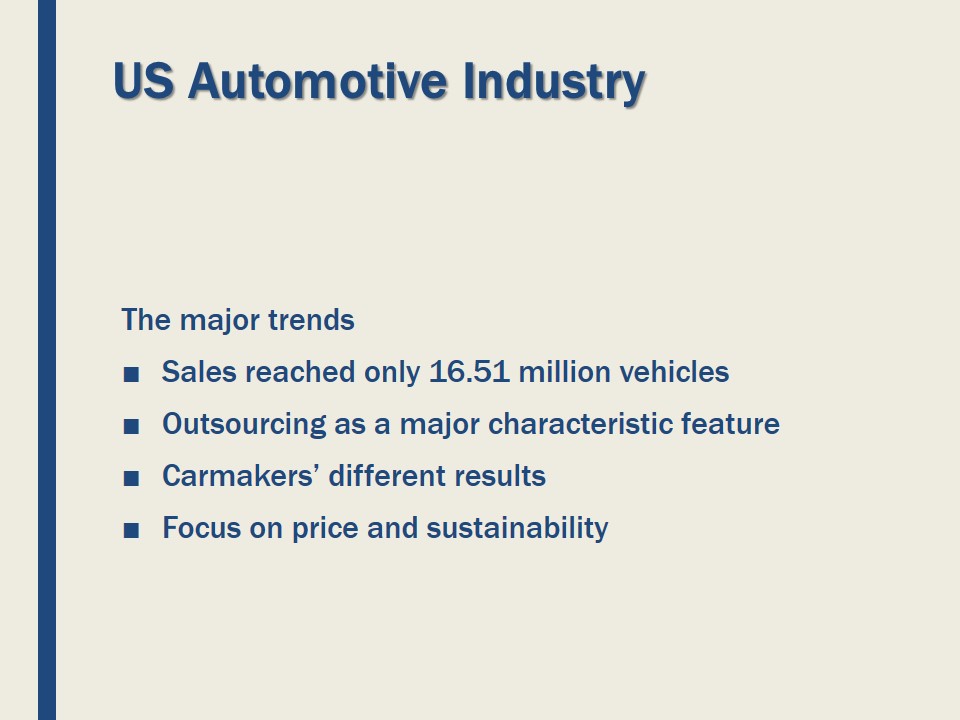
Companies Under Analysis
- Ford,
- Chrysler,
- Nissan,
- Tesla.
Ford, Chrysler, Nissan and Tesla are leading carmakers in the US market (Statista, 2017). The companies offer different products at different prices although some of them focus on certain segments. For instance, Tesla produces exclusively electric vehicles while Chrysler offers luxury cars. Ford and Nissan compete in the segment of mainstream products. It is noteworthy that Tesla’s market share is rising while other companies experience certain difficulties. For instance, some Nissan models’ sales decreased by over 10% (Reuters, 2017). Ford’s sales increased by slightly over 2%, and Chrysler sales dropped by 7%. These carmakers are chosen due to their use of different generic strategies.
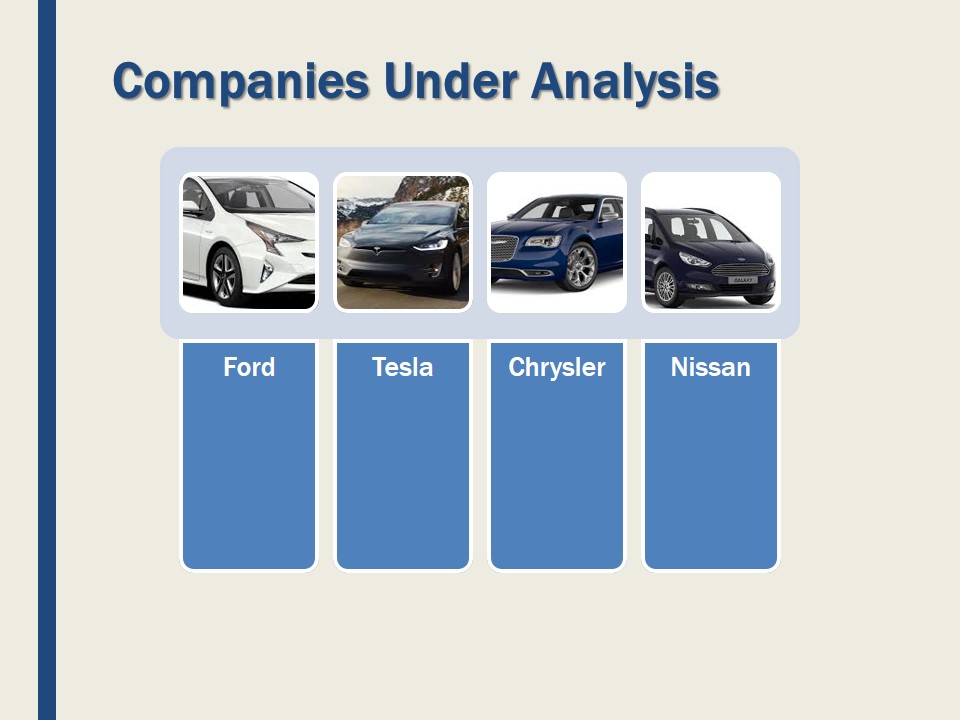
Porter’s Four Competitive Strategies
- Cost Leadership;
- Differentiation;
- Cost Focus;
- Differentiation Focus.
Michael Porter developed a method to identify strategies companies use to obtain and maintain competitive advantage (Tanwar, 2013). The researcher explored the profitability of companies operating in different segments and found that the least profitable firms were businesses that had a moderate market share. Porter assumed that this performance was due to companies’ choice of strategy. The developed model included four dimensions. Porter identified such strategies as Cost Leadership, Differentiation, Cost Focus, and Differentiation Focus strategies. The strategies differ in terms of the companies’ focus on costs, value, or segment. For instance, some firms concentrate on the minimization of costs while others put to the fore unique properties of their products or services.
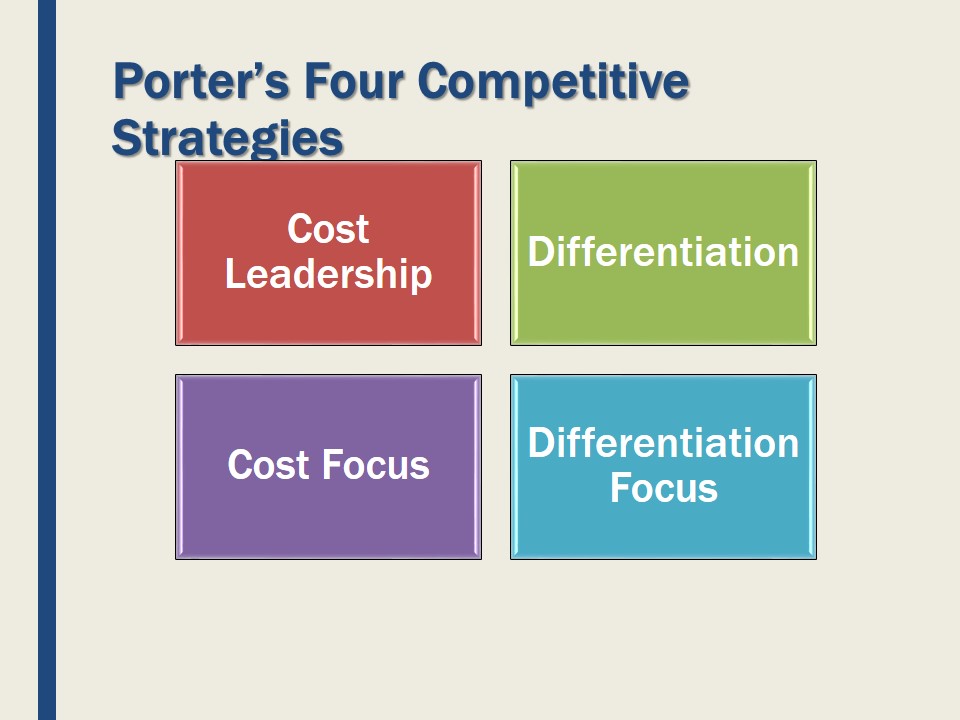
Cost Leadership Strategy
- Companies try to minimize costs;
- Companies use different sources of cost advantage:
- Propriety technology;
- Economies of scales;
- Access to resources;
- Companies set industry average prices.
The cost leadership strategy consists in the focus on the minimization of costs (Tanwar, 2013). Firms try to use all available resources to reduce costs. At that, they do not try to set the lowest prices. The established prices are often industry average. As for the ways used to achieve and maintain low costs, companies use propriety technologies or economies of scale. Some firms may have exclusive access to raw materials, which helps them obtain a competitive advantage. The strategies used often depend on the peculiarities of the industry companies operate in. As for the automotive industry, all these options are available, and carmakers often use the strategies mentioned above or a combination of these strategies.
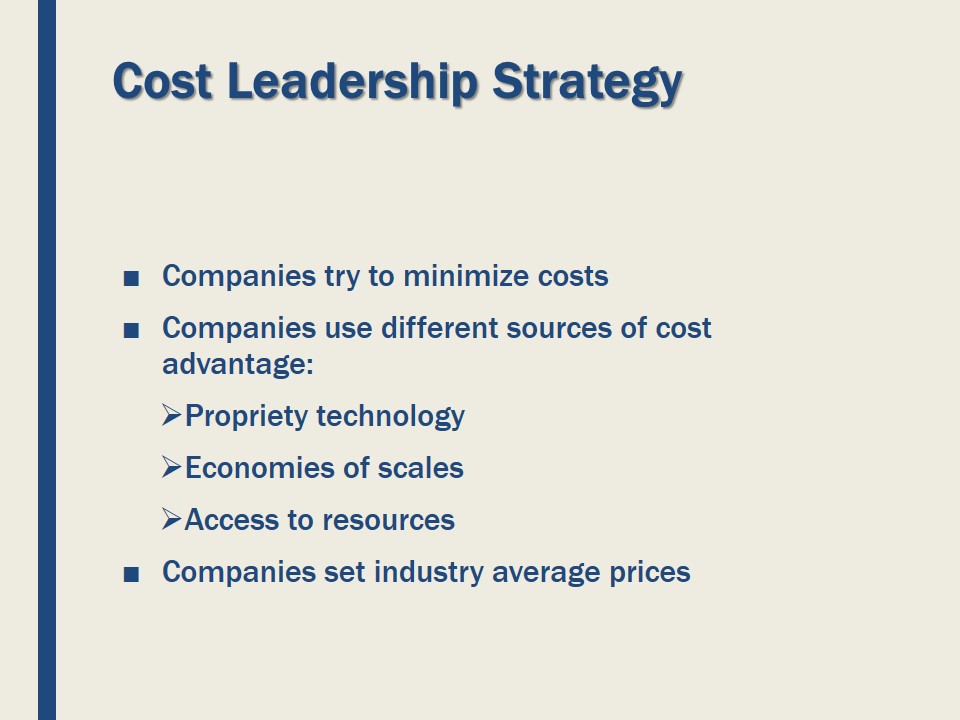
Cost Leadership Strategy: Ford
Ford is an illustration of the company using the cost leadership strategy:
- Prices: industry average or lower.
- Propriety technologies use.
- Production line.
Ford has been exemplary in terms of the use of the cost leadership strategy throughout its history (Parissien, 2013). It developed the production line that ensured mass production of vehicles, which was a revolutionary approach in the 20th century. At present, the company has started using a combination of different methods, but the cost leadership strategy still persists. The company also offers their products at lower prices, which has ensured a considerable market share. This year was quite difficult for the company as sales dropped significantly since their fleet sales decreased by almost 14% (Reuters, 2017).
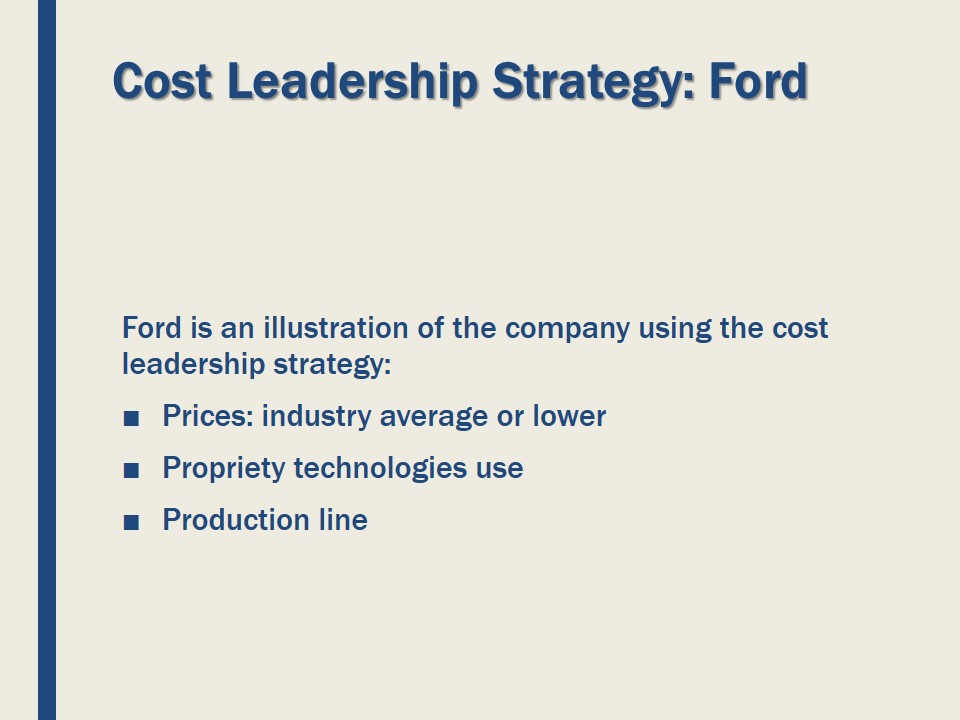
Differentiation Strategy
- The production of high-quality products and services.
- The production of unique products and services.
- Marketing the uniqueness and added values.
- High prices and luxury segments.
The differentiation strategy can be characterized by the production of unique products and services (Tanwar, 2013). These are usually high-quality items that have a certain value. The strategy is utilized when the target customers are not price-sensitive. The use of this method is common for luxury goods. Jewelry, clothing brands, high-end devices attract people with their uniqueness. These products are also associated with well-established brands that are marketed with the focus on quality and some unique features (for example, style, properties, options, etc.).
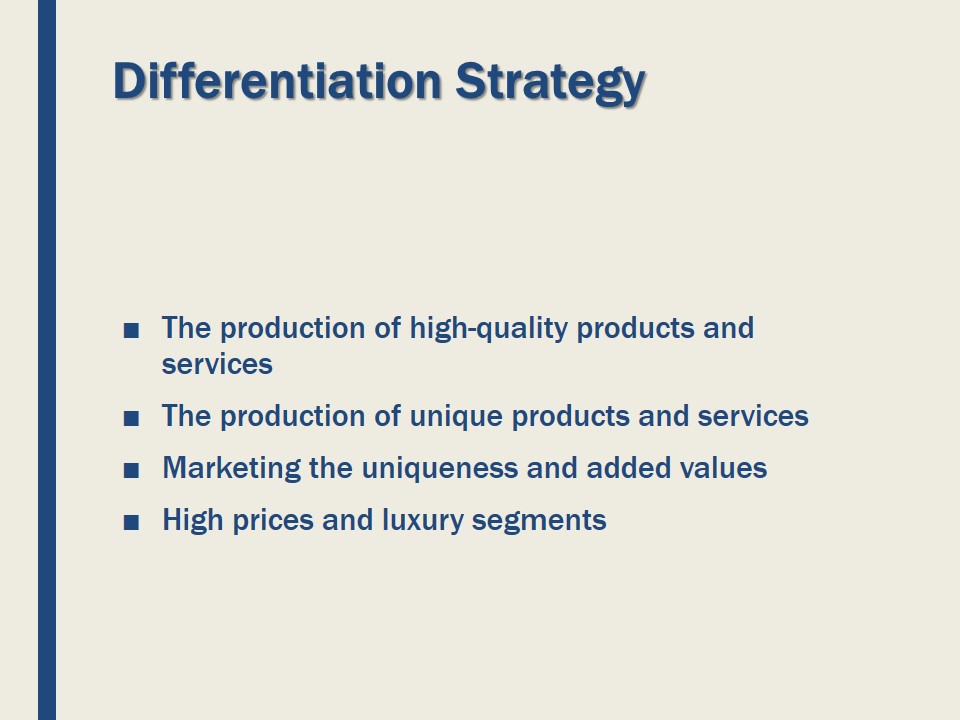
Differentiation Strategy: Chrysler
Chrysler has used the differentiation strategy:
- Well-established brand.
- Luxury segment.
- Focus on high quality.
- Focus on innovation and comfort.
- High-prices stressing the customers’ status.
Chrysler is one of the leading companies in the US automotive industry. The company has history, which is highly valued in the industry as it is associated with quality and reliability. The recent financial challenges had a significant adverse effect on the firm’s performance. For instance, this year, June sales decreased by 7% as compared to the previous year (Reuters, 2017). It is necessary to note that the US economy also faced financial constraints which affected many Americans’ salaries and profits. However, the company still uses the generic strategy that has proved to be effective. The use of the differentiation strategy enables the company to maintain its market share in the luxury segment. Chrysler models are valued for their high-quality, innovation, and comfort. Owning a Chrysler model means having a certain status as well. Customers are ready to pay quite high prices to buy this luxury product.

Focus Strategy (Differentiation)
- Focus on a particular segment.
- Focus on the needs of certain groups of people.
- High-priced products.
- High quality, innovation, reliability, specific properties.
- Well-established brands.
The companies choosing the differentiation focus strategy operate in a particular segment and address the needs of a specific group or groups of people (Tanwar, 2013). The target customers are not price-sensitive. The companies that use this strategy produce high-quality products and services. They draw consumers’ attention to the quality and the properties that respond to these people’s needs. As a rule, successful companies manage to market their brands effectively and create the necessary image.
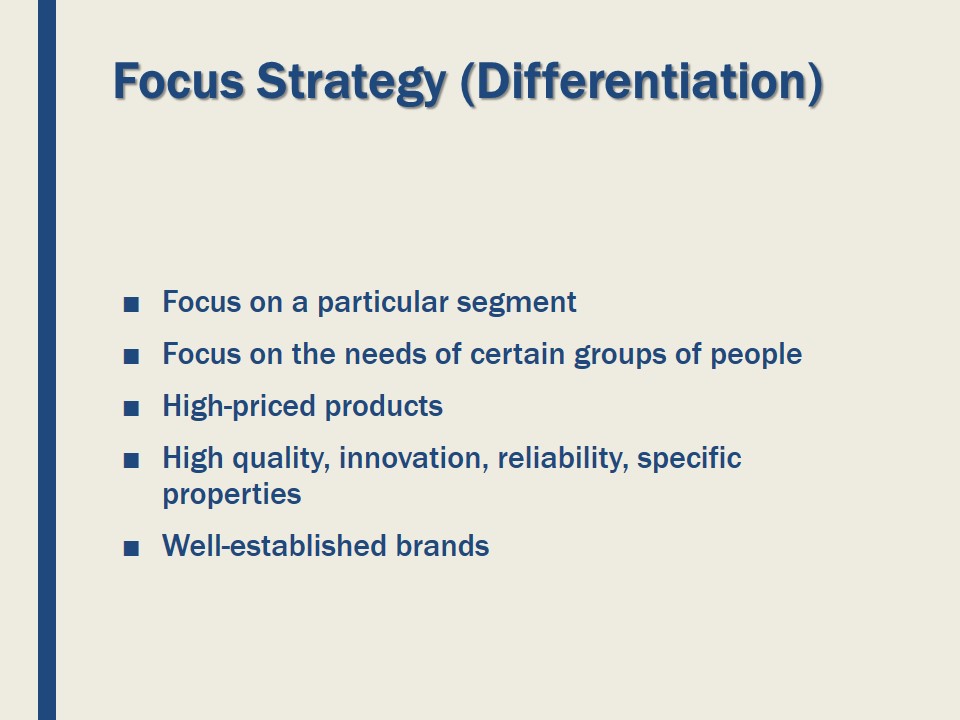
Focus Strategy (Differentiation): Tesla
Tesla is associated with the focus differentiation strategy:
- Segment of electric vehicles.
- Focus on quality.
- Focus on innovation.
- Focus on sustainability.
- High prices.
- Luxury segment.
- Associations with a certain group.
Tesla has a relatively short history as it was established in the 2000s. However, the company is winning a significant market share due to its focus on innovation and sustainability. For instance, the company’s market cap reached over $53 billion at the beginning of 2017 (Krok, 2017). Tesla has used the focus differentiation strategy as it concentrates on a specific segment. The company produces fully electric cars. The company offers luxury models that are sold for approximately $100,000. Even the model that has to be mainstream is sold for $35,000, which is quite a high price. Nevertheless, people are still willing to buy Tesla models and even stand in lines for days (Woodyard, 2016). Tesla is associated with innovation and sustainability. People who are concerned or reveal their concerns about the environment want electric vehicles. Tesla is the company to offer such products. The company focuses on high quality and innovation. Buying a Tesla model means being a part of the society that strives to protect the environment and the very future.
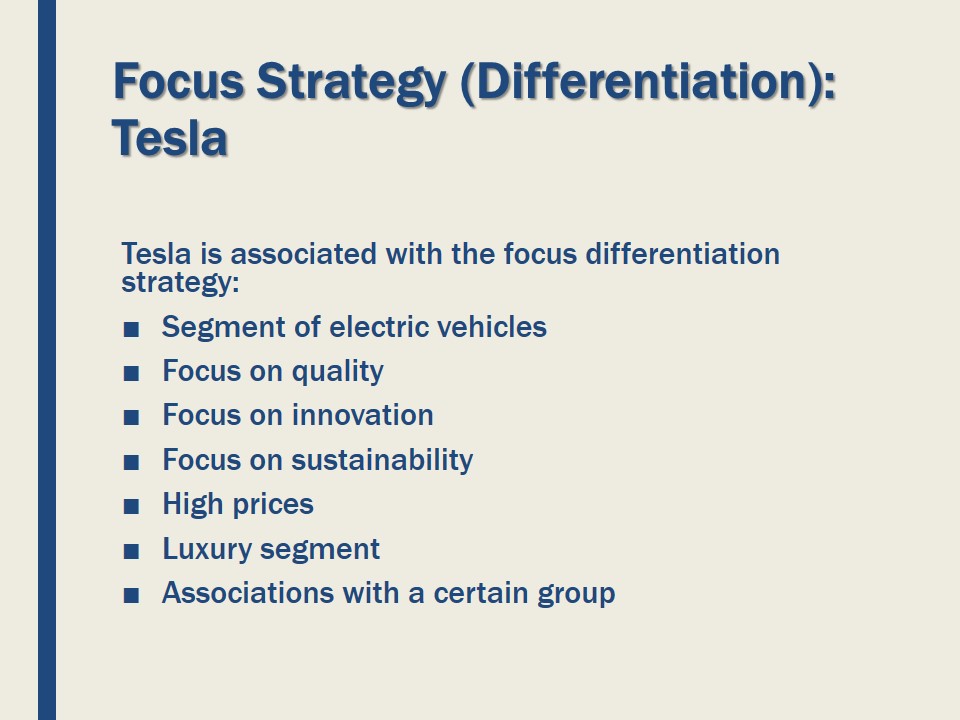
Focus Strategy (Cost)
- The focus on a particular segment.
- The focus on cost reduction.
- Uses economies of scales or other strategies to reduce costs.
- Lowering prices.
- Targets at price-sensitive customers.
The focus cost strategy is quite similar to the cost leadership strategy (Tanwar, 2013). The major difference is associated with the target segment. Companies using the focus cost strategy concentrate on a particular segment, people who may have specific needs. At that, the customers are price-sensitive, which makes firms develop various methods to reduce costs and come up with lower prices. Cost reduction can be associated with such strategies as the use of economies of scales, propriety technology, exclusive access to resources, and so on.
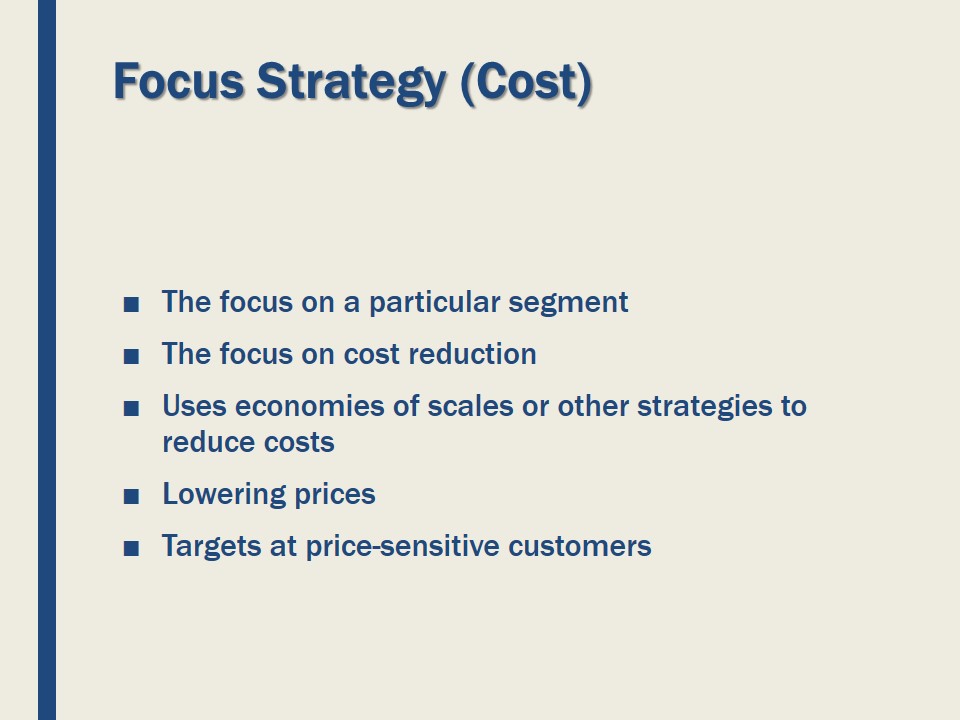
Focus Strategy (Cost): Nissan
Nissan can be regarded as an illustration of the use of the cost focus strategy:
- Operates in the segment of electric vehicles.
- Offers car models at relatively low prices.
- Focuses on cost reduction.
- Produces hybrid cars.
Nissan is an example of the use of the cost focus strategy. The company targets at the market of electric vehicles (Parissien, 2013). The focus is on people’s willingness to be more environmentally friendly and less dependent on gas prices. When marketing its hybrid models, Nissan concentrates on these features. The company sells its models at prices that are lower than its competitor’s offers. To reduce costs, the carmaker produces hybrid rather than fully electric vehicles. The company uses its propriety technologies to reduce costs. Nissan still ensures high quality and safety of its products, which contributes to its models’ popularity.
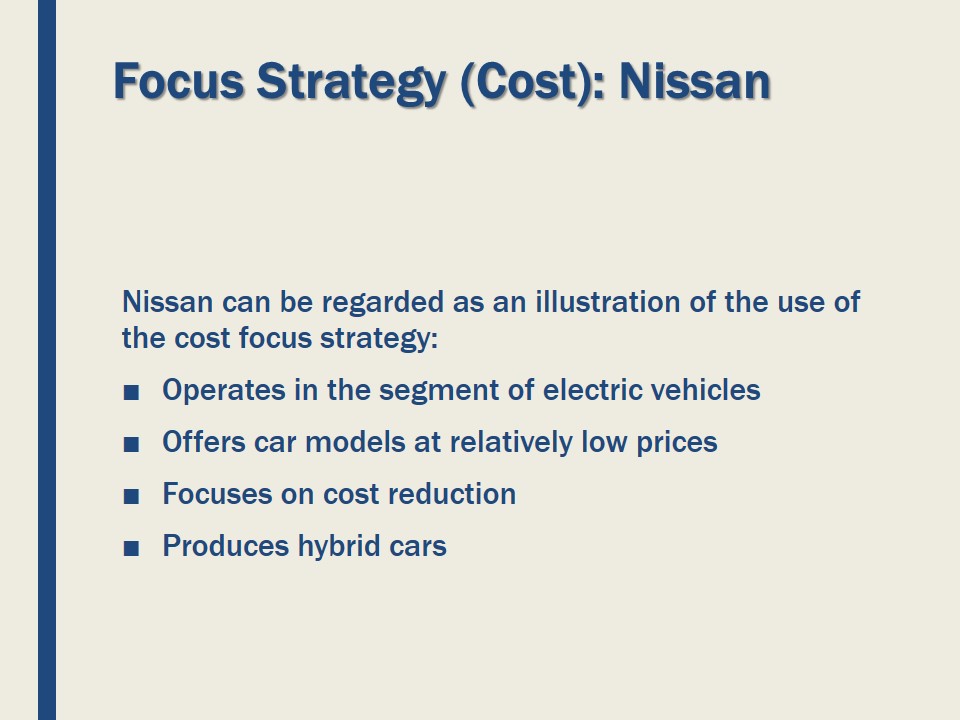
The Use of Porter’s Methods
- Advantages:
- Effective tool to analyze differentiation.
- Easy-to-use method.
- Can be applied in any setting.
- Disadvantages:
- Disregards external environment and internal forces.
- Alternative:
- A combination of methods.
Porter’s model is an effective tool used to analyze differentiation. The method can be used to differentiate between companies operating in one industry. For example, it was easy to evaluate the performance or rather reasons for success or poor results of some companies involved in the automotive industry. The model is easy to use, and it is also well-developed. It can be used to analyze any industry. At the same time, the model has certain weaknesses. It is too narrow as it does not involve the evaluation of other important aspects. External environment and internal forces can be considered to identify the performance of various businesses. For instance, it can be beneficial to use a set of tools. Porter’s five forces can be used as a supplementary method. It can be important to assess a threat of new entry or supplier power. It is possible to conclude that Porter’s generic strategies are useful when differentiating, but the analysis should be facilitated by the use of other methods (for example, Porter’s five forces).
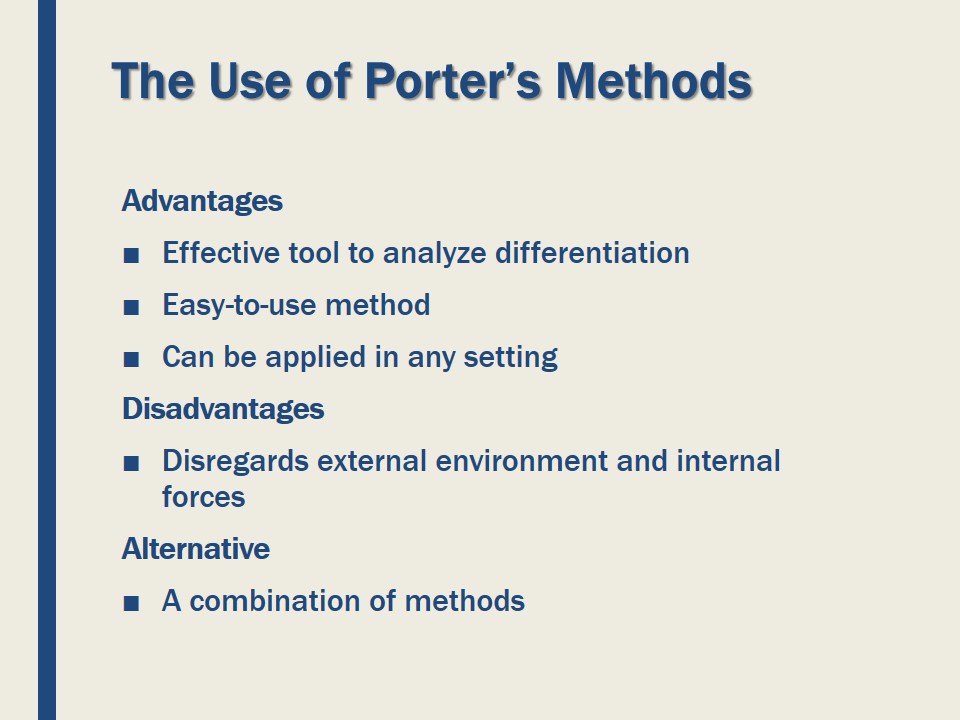
References
Carey, N. (2017). U.S. auto sales fall for fourth straight month in June. Web.
Krok, A. (2017). Tesla is the most valuable US automaker, according to market cap. Web.
Parissien, S. (2013). The life of the automobile: A new history of the motor car. London, England: Atlantic Books Ltd.
Statista. (2017). U.S. Automotive Industry – Statistics & Facts. Web.
Tanwar, R. (2013). Porter’s generic competitive strategies. IOSR Journal of Business and Management, 15(1), 11-17.
Woodyard, C. (2016). Hundreds line up to reserve Tesla’s new Model 3 electric car. USA Today. Web.